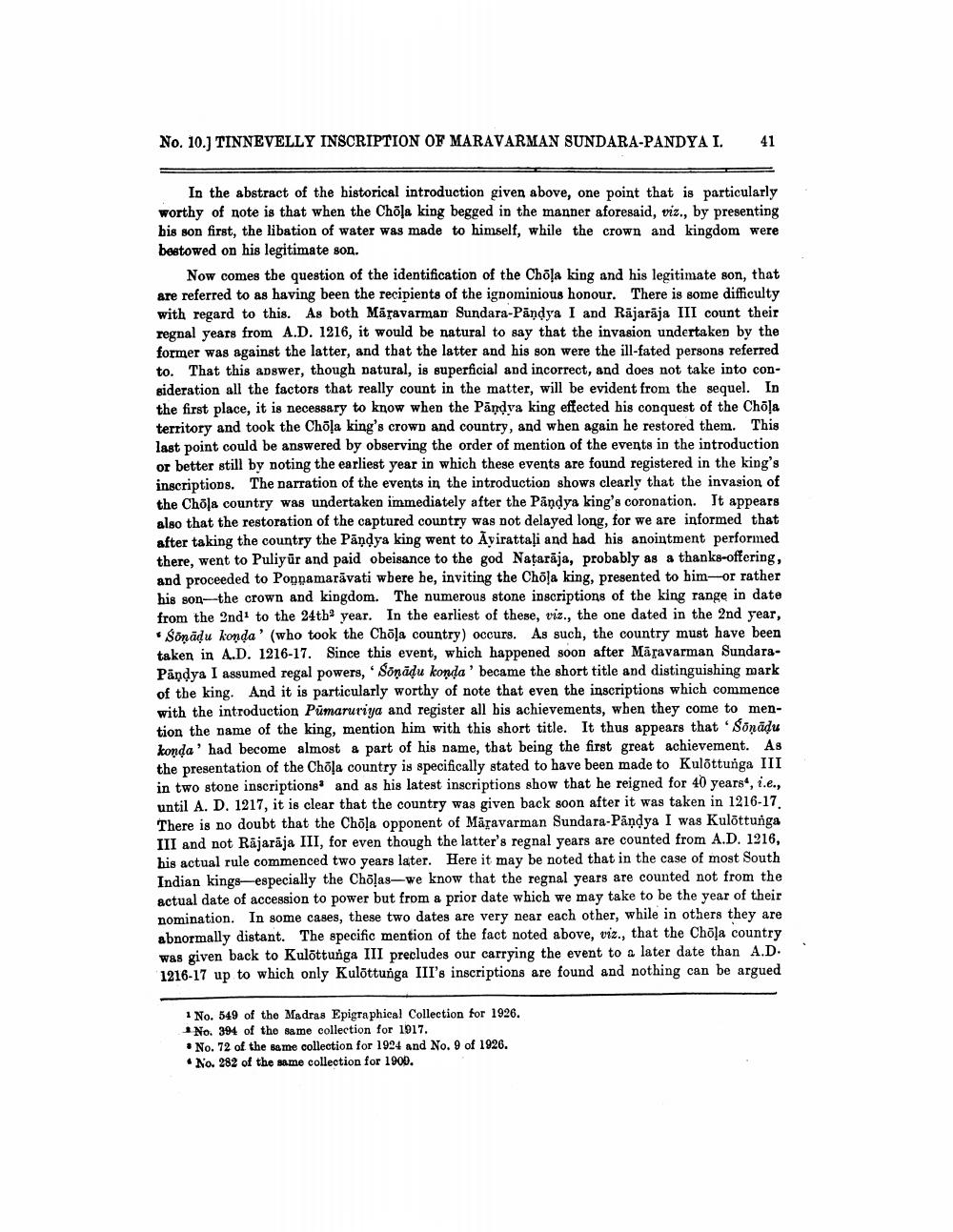________________
No. 10.) TINNEVELLY INSCRIPTION OF MARAVARMAN SUNDARA-PANDYAI.
41
In the abstract of the historical introduction given above, one point that is particularly worthy of note is that when the Chola king begged in the manner aforesaid, viz., by presenting his son first, the libation of water was made to himself, while the crown and kingdom were bestowed on his legitimate son.
Now comes the question of the identification of the Chõļa king and his legitimate son, that are referred to as having been the recipients of the ignominious honour. There is some difficulty with regard to this. As both Maravarman Sundara-Pandya I and Räjarāja III count their regnal years from A.D. 1216, it would be natural to say that the invasion undertaken by the former was against the latter, and that the latter and his son were the ill-fated persons referred to. That this answer, though natural, is superficial and incorrect, and does not take into consideration all the factors that really count in the matter, will be evident from the sequel. In the first place, it is necessary to know when the Pāņdva king effected his conquest of the Chola territory and took the Chāļa king's crown and country, and when again he restored them. This last point could be answered by observing the order of mention of the events in the introduction or better still by noting the earliest year in which these events are found registered in the king's inscriptions. The narration of the events in the introduction shows clearly that the invasion of the Chola country was undertaken immediately after the Pandya king's coronation. It appears also that the restoration of the captured country was not delayed long, for we are informed that after taking the country the Pandya king went to Āyirattaļi and had his anointment performed there, went to Puliyūr and paid obeisance to the god Natarāja, probably as a thanks-offering, and proceeded to Ponnamaravati wbere be, inviting the Chola king, presented to him or rather his son--the crown and kingdom. The numerous stone inscriptions of the king range in date from the 2nd to the 24th year. In the earliest of these, viz., the one dated in the 2nd year, • Sõnādu konda' (who took the Chöļa country) occurs. As such, the country must have been taken in A.D. 1216-17. Since this event, which happened soon after Māravarman SundaraPandya I assumed regal powers, Söņādu konda' became the short title and distinguishing mark of the king. And it is particularly worthy of note that even the inscriptions which commence with the introduction Pumaruriya and register all bis achievements, when they come to mention the name of the king, mention him with this short title. It thus appears that 'Sõņādu konda' had become almost & part of his name, that being the first great achievement. As the presentation of the Chola country is specifically stated to have been made to Kulottunga III in two stone inscriptions and as his latest inscriptions show that he reigned for 40 years', i.e., until A. D. 1217, it is clear that the country was given back soon after it was taken in 1216-17. There is no doubt that the Chola opponent of Māravarman Sundara-Pandya I was Kulõttunga III and not Rajaraja III, for even though the latter's regnal years are counted from A.D. 1216, his actual rule commenced two years later. Here it may be noted that in the case of most South Indian kings-especially the Chöļas-we know that the regnal years are counted not from the actual date of accession to power but from a prior date which we may take to be the year of their nomination. In some cases, these two dates are very near each other, while in others they are abnormally distant. The specific mention of the fact noted above, viz., that the Chöļa country was given back to Kulottunga III precludes our carrying the event to a later date than A.D. 1216-17 up to which only Kulõttunga III's inscriptions are found and nothing can be argued
1 No. 549 of the Madras Epigraphical Collection for 1926.
No. 394 of the same collection for 1917. • No. 72 of the same collection for 1924 and No. 9 of 1926.
No. 282 of the same collection for 1900.




